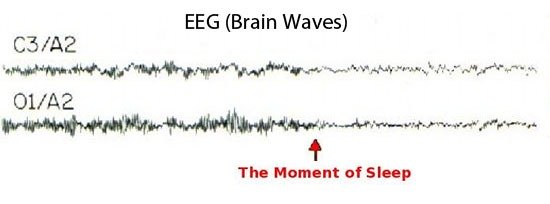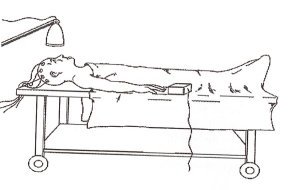
| Connect & Subscribe |
Sleep Onset: What Happens When We Fall Asleep?
Brain Waves, Alpha Rhythms, Perceptual Disengagement, & More
Written by Kevin Morton with adaptations from the Stanford Sleep Book
You may think you can tell when someone falls asleep just by looking at them, and sometimes you may be able to, but can you pin it down to the exact second? Sleep onset is actually a really intriguing topic to consider. What exactly happens at that critical moment when wakefulness suddenly turns into sleep?
Sleep researchers have pinned it down to a few key things. They're listed below, and you can click on each link to jump lower in the page and find out more:
Brain Wave Alpha Rhythms
When the functional state of the brain shifts from wake to sleep, the most reliable and accurate indicator of this sleep onset moment is a characteristic change in brain wave patterns.
Hypnagogia
The word hypnagogia is a perfect one to talk about in a discussion of sleep onset, as it refers precisely to the transitional state between wakefulness and sleep.
All sorts of really interesting things can happen during this brief state, including what's known as hypnagogic hallucinations.
More crazily intriguing things that happen at sleep onset? Lucid dreaming and sleep paralysis are definitely worth reading about.
When we're awake our brain generates a highly characteristic pattern known as an alpha rhythm. A brain wave pattern qualifies as an alpha rhythm if its oscillation is between 8 and 12 cps (cycles per second, or hertz, as is now commonly used).
Interestingly, while an alpha rhythm is present throughout wakefulness it actually is enhanced and even easier to detect when we close our eyes. This is wonderfully convenient because, one, closing ones eyes necessarily precedes sleep and, two, alpha waves are not present during sleep. So when looking at the brain waves of someone resting their eyes during polysomnography, it's that much easier for a sleep researcher to see the change from alpha rhythm to no alpha rhythm.
How easy is it? Well, some individuals have less prominent alpha rhythm that's a bit harder to make out, making the brain wave identification of sleep onset a little less precise. But within a few seconds, sleep onset can be unambiguously determined using brain waves in any case. Check out what it looks like below:
 The red arrow in the brain waves above pinpoints the moment of sleep onset. To the left of the arrow the subject is awake and his or her brain emitting large, sharp alpha rhythms on both EEG measuremens. To the right of the arrow those rhythms cease to exist and the subject is asleep. Just FYI, "C3/A2" and "O1/A2" just signify the different areas of the brain where these readings are being taken. Alpha rhythms tend to show up most prominently in the occipital area, or O1. You can see the alpha rhythm is more sharp in this measurement than in C3, which is near the top of the skull.
The red arrow in the brain waves above pinpoints the moment of sleep onset. To the left of the arrow the subject is awake and his or her brain emitting large, sharp alpha rhythms on both EEG measuremens. To the right of the arrow those rhythms cease to exist and the subject is asleep. Just FYI, "C3/A2" and "O1/A2" just signify the different areas of the brain where these readings are being taken. Alpha rhythms tend to show up most prominently in the occipital area, or O1. You can see the alpha rhythm is more sharp in this measurement than in C3, which is near the top of the skull.
Slow Eye Movements
Another common feature of sleep onset is the occurence of slow, back and forth eye movements. These movements sometimes begin a few seconds before the EEG change in alpha rhythm if the eyes are closed leading up to sleep, and generally continue for several minutes after sleep onset.
In contrast to the rapid movements our eyes make during wakefulness and REM sleep, the slow eye movements of sleep onset aren't always binocularly syncronous (i.e. the left eye doesn't always move exactly with the right eye).
Perceptual Disengagement
Perceptual disengagement from the environment, one of the two main defining qualities of sleep, is the most salient feature of sleep onset. The occurence of sleep initiates a total lack of conscious awareness of the outside world for any stimuli that doesn't elicit arousal. So when a stimulus fails to elicit a response it would always elicit in the waking state, we know that person is asleep. Check out the experiment below to get a better sense of what I mean here.Strobe Light Experiments
To test just how dramatic the change in consciousness is at the moment of sleep, researchers once conducted a series of experiments involving strobe lights, a microswitch, and tape.
Adult volunteers took turns laying down on a gurney with an extremely bright (we're talking 50,000 lux) strobe light hanging six inches above their eyes. The researchers taped the participants eyelids open, and put a small switch against their finger with the instructions that every time the participants saw the strobe light flash they must press the switch. Easy enough, right? I mean, we're talking about a 50,000 lux strobe light flashing 6 inches in front of your face. How could you miss that?

Well, despite having their eyes open the entire time, the participants did miss the strobe light flashes whenever they were asleep while they went off. When brain wave recordings being taken simultaneously showed the participants to be awake, not one failed to press the switch after a flash, without exception.
But whenever the brainwave patterns showed the participant had slipped to non-REM stage 1 sleep (the lightest stage of sleep), the subjects failed to press the switch and even denied that there had been a strobe flash after the fact! This was invariably true even if the flash followed the brainwave change by less than a second, or in other words, right after sleep onset.
Talk about amazing evidence of our sensory disengagement while we sleep! But how is it exactly that we can be completely unaware that a 50,000 lux strobe light flashed half a foot ahead of our open eyeballs? Further research has shown that the electrical response of our relay neurons responsible for transmitting sensory information to appropriate parts of the brain actually almost completely disappears during sleep. The brain doesn't get told because the messengers can't deliver the message!

Dr. D's Sleep Book Says...
"This is clear evidence that an independent brain process dramatically alters the processing of sensory information in association with the moment of sleep onset, but not before this moment."
Go from Sleep Onset to "What Is Sleep?" The Sleep Essentials guide's parent article to this page.
What happens after Sleep Onset? Go here to learn about NREM Sleep
About This Site
Welcome! This site is continuously being created by students of Dr. William C. Dement's Sleep And Dreams course at Stanford University.
We made this site as a call to action for people all over the world to live healthier, happier, safer, and more productive lives by learning about their own sleep. We have faith that reading the information provided on this site will motivate you to be smart about your sleep deprivation and strategic about your alertness in order to live life to your fullest, most energetic potential.
In fact, we challenge you to do so! What do you say, are you up for the challenge?
Interviews With Sleep Specialists: Insights Into the Worlds of Sleep Medicine & Sleep Business
America's Most Dangerous Disorder: What Is Sleep Apnea Doing To Your Sleep?
Sleep Debt: How Much More Will You Achieve When You Reduce Yours?
The Stages Of Sleep: The Journey Through The Night
Delayed Sleep Phase: You Want To Sleep But You're Not Tired Yet
Paralyzed at Night: Is Sleep Paralysis Normal?
Sleep In Words: Smart, Strange, and Funny Quotes About Sleep
Sleep Disorders In Children: What's Keeping Your Child From A Full Night's Rest?
Attacks of Pavor Nocturnus (a.k.a. Sleep Terrors, Night Terrors, or Incubus Attacks)
The Stanford Sleep Book
Dr. Dement's pioneering textbook has been the core text for Sleep and Dreams since 1980, but it has just recently been made available to the wider public for the first time.
In it you'll find a more detailed account of the most important things you need to know about sleep, alertness, dreams, and sleep disorders. Studies, statistics, plus plenty of Dr. Dement's classic anecdotes painting the history of sleep medicine.
Preface | Intro | Contents | Get A Copy
More Sleep Resources
The Zeo
A revolution in personal sleep tracking, the Zeo is a wireless headband that transmits your brainwaves in realtime to a dock (pictured here) or your smartphone. The result? You can wake up and see exactly what stages of sleep you were in during the night! Unprecedented personalized sleep knowledge.
Sleep Paralysis: A Dreamer's Guide
Ever woken up paralyzed? A surprising number of us have, believe it or not. But few know the actual causes of this phenomenon, and fewer still how to exert control over it. Dream researcher and sleep paralysis expert Ryan Hurd shares breakthrough insights into how to do just that.
Important Disclaimer
Please Note:
The information found on this page and throughout this site is intended for general information purposes only. While it may prove useful and empowering, it is NOT intended as a substitute for the expertise and judgments of healthcare practitioners.
For more info, see our
Terms of Use.









